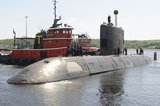US Navy testing mid-ocean missile restocking system in case of conflict with China
The USS Chosin, which is testing the missile restocking system. (Photo: Gunnery Sgt. Ajiboye Magbagbeola, US Navy)
The US Navy (USN) is testing a system for reloading warships with missiles while they are at sea. The move is a safeguard against any prolonged war between the US and China in the western Pacific, US Navy Secretary Carlos Del Toro explained to The Wall Street Journal.
Modern warships are equipped with as many missiles and weapon systems as are deemed appropriate and feasible for the conflicts and environments they are most likely to encounter in their active service life.
But now, USN engineers have adapted a 30-year-old crane and attached it to a warship, effectively jury-rigging a prototype missile resupply system between the USNS Washington Chambers, a supply ship, and the Ticonderoga-class missile cruiser USS Chosin.
Related Articles
HII awarded contract for aircraft carrier maintenance in San Diego
US Navy extends life of 12 Arleigh Burke destroyers
A recent test of the system allowed dummy missile containers to be zip-wired between the vessels, proving the concept of at-sea missile re-stocking.
If tests of the system continue to be successful, the so-called Transferable Reload At-sea Method (TRAM) could be included on all warships during their modernisation or refit phases. That could be sooner rather than later in some cases, as the USN is extending the lifespan of a growing number of its older Arleigh Burke-class destroyers.
Why restock a warship at sea?
Secretary Del Toro explained why the TRAM prototype was being tested.
Any upcoming war with China, he said, would be fought in the Western Pacific.
That would leave a large part of US naval effectiveness hampered by being anything up to 5,000 miles from the nearest naval base that could restock warships with missiles.
Of all the vessels that currently make up US naval power, only around 11 nuclear-powered aircraft carriers and nine smaller assault ships have the ability to sustain themselves indefinitely.
For most modern vessels in the US fleet, if they were to fire all their missiles when they happened to be engaged 5,000 miles from a naval base, it could take up to two months before they could be restocked and back in the fray.
Secretary Del Toro said the mid-ocean restocking capability of TRAM was critical to any future conflict in the Pacific.
The USN plan to upgrade older warships could also increase the number of vessels capable of indefinite action at sea to around 100.
The Navy is reportedly looking for lateral solutions to the problem too, identifying friendly bases in the southern hemisphere that could cut down the missile-restocking time of the US fleet in any sea war with China.
Darwin in Australia is being considered, which would cut a three-week trip back to the US down to around five days, assuming the sailing route was unencumbered by adversary vessels.
Meanwhile, how fast an effective US fleet could be modified with the TRAM system ahead of any Western Pacific engagement remains to be seen. Secretary Del Toro said he expected the system would go into service within the next two to three years.
Related Equipment in Defence Insight
More from Naval Warfare
-
![Maritime defence in the Mediterranean faces challenges from vulnerable land power]()
Maritime defence in the Mediterranean faces challenges from vulnerable land power
As an indispensable energy crossroads, the Mediterranean is at serious risk from grey zone disruption. As navies increasingly employ AI data centres, what happens when cutting-edge defence technologies rely on the very infrastructure most susceptible to hybrid tactics?
-
![US Navy to conduct an experimentation campaign with emerging tech in 2026 and 2027]()
US Navy to conduct an experimentation campaign with emerging tech in 2026 and 2027
The Technology Operational Experimentation Events will inform future requirements as the US Navy looks for innovative solutions across three key operational domains.
-
![Future Canadian Continental Defence Corvette will provide “Halifax-equivalent capabilities”]()
Future Canadian Continental Defence Corvette will provide “Halifax-equivalent capabilities”
Although the CDC project is still in its early stages, the Canadian Department of National Defence already has some requirements for the future platforms.






















